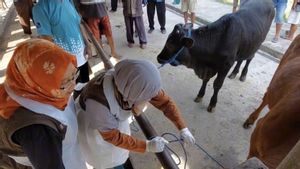JAKARTA - No one knows for sure when the history of coffee drinks began. Referring to the United States Coffee Association (NCA), traces of its origins can be traced from ancient coffee forests in the land of Ethiopia.
The people there believe that the person who first discovered the coffee beans was a goat herder named Kaldi. Once upon a time, he found coffee after watching his goat eat the fruit from a tree. After eating the fruit, his goat became so energetic that he didn't sleep all night.
Then Kaldi told his experience to the local abbot. They then mix the coffee fruit into a drink that can keep him up all night to worship. The discovery then extended to the Arabian peninsula.
Developed in ArabiaThe cultivation and trade of coffee first started in Arabia. In the 15th century, coffee was originally planted in Yemen, a century later it expanded to Persia, Egypt, Syria to Turkey.
It turns out that along with the increase in coffee lovers, coffee shops have started to mushroom in that century. The cafes first existed in cities in the Near East (Syria, Iraq and Iran).
The cafe is known as "Qahveh Khaneh" which means policy school. It is so called because the place has developed into an important information exchange center, as it has become a gathering place for artists and writers.
Enter EuropeThe habit of consuming coffee in Arabia is becoming known to travelers who come from Europe. Those who like it then bring the black drink to their hometown. From there coffee first spread in Europe.
In the 17th century, coffee made its way to Europe and became popular across the continent. Various reactions emerged. Not everyone welcomes coffee. Some people suspect coffee as "the devil's bitter drink."
In addition, in Venice, in 1615 coffee drinks were criticized by local religious leaders. This controversy then spread to the ears of Pope Clement VIII.
Clement VIII was asked to step in to mediate the coffee problem. He then tasted the drink before making a decision. Then he tasted the drink so satisfying that he finally gave papal approval.
Despite such controversy, coffee shops quickly became centers of social and communication activity in major cities in England, Austria, France, Germany and the Netherlands. In England there is even a “penny university” term for a shop that sells coffee drinks for one cent. It is also a place for people to chat.
Since then coffee began to replace breakfast drinks such as beer and wine in Europe. Those who drink coffee will start the day full of energy and increase work productivity.
Fortunately the Dutch from BataviaThe boom in coffee connoisseurs keeps the demand soaring. Coffee is a commodity whose trade has led to feelings outside of Arabia. One of the big players outside of Arabia is the Netherlands.
In 1616, the Dutch began making the first coffee plantations in Europe. Which then has to do with the creation of the first European-owned coffee plantations in the Dutch East Indies.
At that time, the Netherlands was in full swing to increase coffee production. To increase their agricultural capacity, they initially opened coffee fields in India but failed. His business was only successful when he opened a coffee farm in Batavia, which was called Jakarta in the past.
In Batavia, coffee plants flourished and soon the Dutch had a productive and growing coffee trade. They then expanded coffee tree planting to the islands of Sumatra and Sulawesi. The Netherlands finally enjoyed the glory of coffee farming planted on the land of the Dutch East Indies.
As production capacity increases, drinking coffee has become a widespread culture in many regions of the world. No exception in Indonesia.
The English, Chinese, Japanese, Arabic, and French versions are automatically generated by the AI. So there may still be inaccuracies in translating, please always see Indonesian as our main language. (system supported by DigitalSiber.id)









